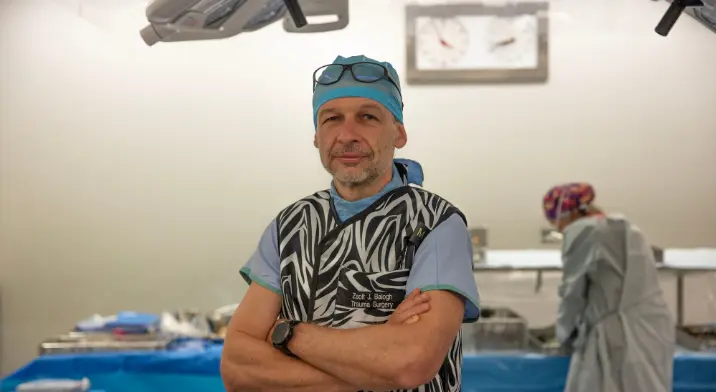
2023 HMRI Researcher of the Year, Professor Zsolt Balogh wants polytrauma recognised as a disease by the World Health Organization. It’s currently recognised in the category of acute injury, but if his work comes to fruition, it will be recognised as a disease.
Professor Zsolt Balogh is an international leader in surgical, trauma and musculoskeletal research, education and clinical care. He is the Discipline Head of Traumatology and Surgery at the School of Medicine and Public Health, University of Newcastle, the Director of Trauma at John Hunter Hospital and Hunter New England Local Health District. He also leads the Injury and Trauma Research Program at the Hunter Medical Research Institute. Professor Balogh is a busy practicing trauma and orthopaedic surgeon with a major interest and expertise in complex polytrauma patient management, traumatic shock resuscitation, postinjury multiple organ failure and pelvic and acetabulum fracture patients.
“It has all the aspects of a disease and yet it’s not treated as such,” says Professor Balogh.
What is Polytruma
Polytrauma is what happens when someone suffers from massive transfer of kinetic energy, like what happens in a car crash, fall from height, or a pedestrian hit by car. There are obvious physical injuries but there are less obvious secondary implications like major inflammation of the entire body and failure of organs not even injured in the first place.
“We know that people who have suffered polytrauma will have worse outcomes among the injured, in both the short-term and long-term. But it is underappreciated that they have a higher risk of heart disease, diabetes, cancer and other chronic degenerative diseases because they burn out their regenerative capability in the acute phase of polytrauma.
“Overall their life expectancy is shortened. This is very alarming even without the life-long psychological consequences of polytrauma. To me, this is both scary and fascinating. Injury is imagined as an accident and acute problem, which may make it to the news. The ongoing chronic impact isn’t really recognised.
“Every tissue has a certain hidden clock that dictates how long cells can reproduce and rejuvenate themselves, the battery life of this clock is shortened due to polytrauma. I am interested in trying to understand how to rejuvenate and reprogram injured organs so that I can increase the survival of salvageable injured cells and hopefully maintain their potential to reproduce long-term,” says Professor Balogh.
As Head of Traumatology at Newcastle’s John Hunter Hospital, Professor Balogh manages around 1,500 severely injured patients each year. Up to 400 of these patients classify as polytrauma.
How kinetic energy leads to polytrauma
In 2021, Physiology and Medicine Nobel Prize winners David Julius and Ardem Patapoutian discovered the presence of cellular receptors for temperature and touch, leading to a deeper understanding of what is happening on a cellular level after a traumatic injury.
“We learnt recently that the kinetic energy transfer to the body that causes the deformation and pressure on the cells is what makes them dysfunctional.” said Professor Balogh.
“There are Piezo receptors in the cell membrane that detect pressure. When this happens, the receptors open up iron channels for calcium influx which then interfere with cellular functions like energy transformation, cell reproduction and disposal. This disruption speeds up the ageing process and causes inflammation in the body”.
Because of Professor Balogh, 92% of the most severely injured 500 patients coming through John Hunter Hospital ar enow surviving, However this means that there are now an additional 400 people a year in the Hunter alone that will experience polytrauma.
The impact of polytrauma
The hospitalisation of polytrauma patients is complicated by intense inflammation caused by their injuries and their essential treatment, which frequently shuts down the function of uninjured vital organs leading to multiple organ failure.
Survivors of polytrauma are at high risk of developing chronic diseases such as diabetes, heart disease, and cancer, and they have a shorter life expectancy.
There is no known treatment…yet
There is currently no Australian Government funding for polytrauma research
Professor Balogh has been working with the World Health Organization to have polytrauma included in the new version of the International Classification of Diseases for the past two years. The final committee meeting is imminent.
If polytrauma received recognition as a disease, it is hoped that governments might finally support it with the research funding it needs to find earlier, better treatments.
How you can avoid injury during the festive season
The festive season is a time for joy, celebration, and togetherness, but it’s also a time when incidents like car crashes and injuries are tragically more prevalent.
During the holidays, the combination of increased travel, busy schedules and distractions – along with the excitement of new scooters, skateboards, and bikes received for Christmas can tragically lead to injuries and, in some cases, loss of life.
Professor Balogh says that “in trauma science, we consider that most of these injuries are not accidents because they are preventable”.
Drive Safely: Stay focused, avoid distractions like mobile phones, and never drive under the influence of alcohol, drugs or fatigue. Make sure your vehicle is in good condition, and allow extra time for travel to avoid speeding.
Practice Pedestrian Safety: When walking or cycling, use designated crossings and wear reflective clothing or lights if out at night.
Use Protective Gear: Ensure that children and adults alike use helmets and protective pads when using scooters, skateboards, bikes, or ATVs. Follow the manufacturer’s safety instructions for any new recreational equipment.
Supervise Activities: Keep a close eye on children during playtime, especially when they are using new toys or outdoor equipment that they may be unfamiliar with.
Stay Mindful of Your Surroundings: With busy schedules and large gatherings, it’s easy to overlook hazards. Take the time to declutter pathways in your home and secure decorations or cords to prevent trips and falls.
Manage Stress and Fatigue: The holidays can be tiring with many events and obligations. Be mindful of your limits and ensure you get enough rest to stay alert and reduce the risk of accidents.
Limit Alcohol Consumption: If you’re celebrating with alcohol, do so responsibly. Make sure there are designated drivers or alternative transport arrangements to prevent impaired driving.
Keep First Aid Supplies Handy: Ensure you have a well-stocked first aid kit and are familiar with basic first aid practices to respond quickly to minor injuries, especially when travelling.
If you would like to give the gift of a charitable donation this festive season, please consider donating to HMRI. All donations are tax-deductible.
HMRI would like to acknowledge the Traditional Custodians of the land on which we work and live, the Awabakal and Worimi peoples, and pay our respects to Elders past and present. We recognise and respect their cultural heritage and beliefs and their continued connection to their land.

Hunter Medical Research Institute
We’re taking healthy further.
Locked Bag 1000
New Lambton
NSW, Australia, 2305



This site is protected by reCAPTCHA and the Google Privacy Policy and Terms of Service apply.
Copyright © 2024 Hunter Medical Research Institute | ABN: 27 081 436 919
Site by Marlin Communications
